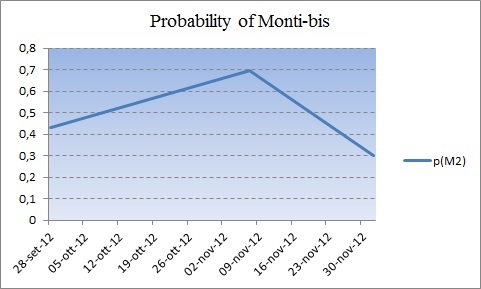The victory of Pierluigi Bersani in the primary elections for the leadership of the Democratic Party in Italy reduces the chances of the Monti Agenda.
 In September I discussed in Economonitor the plausibility of a “Monti bis”, the possibility that the next Italian government will carry forward the ‘”Monti Agenda” of budgetary discipline and structural reforms, with Mario Monti still playing an important role. The probabilistic model assumes that the outcome depends on two factors: the type of electoral reform to come out of Parliament, and the leaderships of the two main parties. A proportional system would increase the chances of the “Monti bis”, because it produces weak coalition governments at parliamentary level, while a reform leading to a large majority premium would have the opposite effect. The Monti Agenda is more likely with moderate leaders in the right and left (Alfano and Renzi, respectively), and less likely with more ideological leaders (Berlusconi against Bersani allied with the extreme left).
In September I discussed in Economonitor the plausibility of a “Monti bis”, the possibility that the next Italian government will carry forward the ‘”Monti Agenda” of budgetary discipline and structural reforms, with Mario Monti still playing an important role. The probabilistic model assumes that the outcome depends on two factors: the type of electoral reform to come out of Parliament, and the leaderships of the two main parties. A proportional system would increase the chances of the “Monti bis”, because it produces weak coalition governments at parliamentary level, while a reform leading to a large majority premium would have the opposite effect. The Monti Agenda is more likely with moderate leaders in the right and left (Alfano and Renzi, respectively), and less likely with more ideological leaders (Berlusconi against Bersani allied with the extreme left).
In September, the Monti calculator gave an initial estimate for the Monti-bis probability at 43%, since
• Berlusconi seemed determined to run as the PDL candidate;
• Bersani was favored against Renzi (respectively 60% and 40% chance of being a leader of the Democratic Party);
• The debate on electoral reform favored a “proportional” system;
In November, some developments significantly altered the political framework favoring moderate leaderships and a “hung parliament”:
• Berlusconi declared that he would not run;
• Renzi popularity rose (almost to 50%);
• There electoral reform seem to favor a proportional-like system;
This led to the Monti-bis probability to exceed 50%.
But today, we have three new important features:
• Bersani won the primary elections for the Democratic party leadership possibly with the votes of the extreme left;
•Berlusconi is now more likely to run again;
• It is more likely that there will not be any electoral reform.
Consequently, as can be seen from the figure, the predicted probability of the Monti bis drops dramatically, to 30% (see the Figure)

